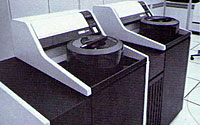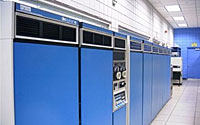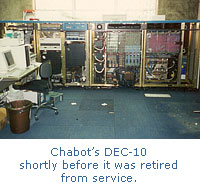|
The Day the Computer Stopped – Almost Permanently!
Submitted by Bill Threlfall
District and Chabot College
One of my most memorable experiences occurred in 1992 as I began new
duties as Chief MIS Officer for the Chabot-Las Positas Community
College District. Though I had been an active user of computers for
years at Chabot and had led the selection process for the District's new
hardware and software, in my new job I assumed full responsibility
for all administrative computing in the District. Two days after I
started, I thought I might be fired. The story has a bit of detail,
but I'll try to keep it non-technical:
 I
started duty on a Thursday, getting my feet on the ground. When I
entered the office on the following Monday morning, the staff who
were already present had long faces and downcast eyes. They
explained that the air conditioning system for our ancient main
computer, the "DEC-10", had failed over the weekend, resulting in 95
degree temperatures in the computer center. The DEC-10's disc drives
could not tolerate such temperatures, and several were severely
damaged. Significantly, one of these was the "boot" drive, which is
used to start the system and load its operating system software into
memory. I
started duty on a Thursday, getting my feet on the ground. When I
entered the office on the following Monday morning, the staff who
were already present had long faces and downcast eyes. They
explained that the air conditioning system for our ancient main
computer, the "DEC-10", had failed over the weekend, resulting in 95
degree temperatures in the computer center. The DEC-10's disc drives
could not tolerate such temperatures, and several were severely
damaged. Significantly, one of these was the "boot" drive, which is
used to start the system and load its operating system software into
memory.
 During
Monday, all the drives were repaired by Digital Equipment
Corporation (DEC) technicians. Now all we needed to do was (1) start
the computer and (2) restore the contents of the repaired drives
from backup tapes… During
Monday, all the drives were repaired by Digital Equipment
Corporation (DEC) technicians. Now all we needed to do was (1) start
the computer and (2) restore the contents of the repaired drives
from backup tapes…
For the failed disc drive that starts the computer, we had spare
disk packs that could be quickly mounted in the drive by the
computer operator, providing prompt restoration of service.
Unfortunately, neither spare pack proved readable. We were only able
to start the computer using the original DEC factory system pack,
but using it we were "up" and running! However, this was the
equivalent of returning your home computer to the condition it was
in when you first took it out of the box and started it up; we had
no programs or data available – just a bare factory release
operating system.
Now it was time to restore the contents of the rest of the repaired
disc drives from tape backups so that all our programming and data
would be available. These data included registration information,
personnel information, accounts receivable and payable information,
etc.
Where were all these programs and backup data? On the backup tapes.
Here comes the problem: By 1992, the DEC-10 was obsolete, having
been out of production since 1983. To update it, our staff had
installed newer "high-density" tape drives that outperformed the
original ones, and they had modified the computer's operating system
to allow it to use these high-density drives. Unfortunately, when we
started the computer from the DEC system disc which lacked those
modifications, it could not read the backup tapes.
I asked, "Where is the modified version of the operating system
which can read the tapes?" The answer was, "On the tapes!" This was
extremely bad news, because it meant the software required to read
the tapes was stored on the tapes we couldn't read – "catch-22".
We were down nearly two weeks. During most of this time, it appeared
that we were facing possible disaster – that all registration, personnel,
and finance data would be lost permanently, along with all the
programs written by our staff over the past decades. DEC sent an
engineer from Colorado who was unable to resolve our problem. We had
nearly exhausted all options when Eric Stricklen, our systems
administrator for the DEC-10, found an old 8" floppy disc that
contained the high-density tape drive modifications we needed. Once those were
restored to the system drive, we could read the backup tapes and the
full system was back up soon thereafter.
Whew! A rough start to a new job…
Lessons
I took two key lessons from this experience:
First, a commitment to keep the operating system of our new computer
(that was being installed to replace the DEC-10) in an up-to-date
and
unmodified condition, so that in an extreme emergency, we could
restore our tapes to similar computer hardware at another
site.
Second, an understanding that our most important asset was the
magnetic image of data and software on our backup tapes, and that we
must take every precaution to guard the integrity of that backup
image: off-site backup storage, fireproof vault for tape storage; test restorations, etc.
Our practices followed those lessons during my years at CLPCCD MIS.
About the DEC-10
 Digital
Equipment Corporation was a key player in the mainframe and
mini-computer business of the 1970s and 1980s. The DEC System-10 was
the company's flagship product until it was discontinued in 1983,
after being superseded by the VAX minicomputer systems. DEC-10s were
leaders in establishing "time-sharing" by multiple concurrent users
and were popular in academic settings. Digital
Equipment Corporation was a key player in the mainframe and
mini-computer business of the 1970s and 1980s. The DEC System-10 was
the company's flagship product until it was discontinued in 1983,
after being superseded by the VAX minicomputer systems. DEC-10s were
leaders in establishing "time-sharing" by multiple concurrent users
and were popular in academic settings.
Our DEC System-10 was originally purchased in the 1970s and went
through two subsequent upgrades. In its final configuration (KL-1091), it
was about the size of seven refrigerators and seven washing
machines and required a dedicated room with fire suppression and air
conditioning. We had spent about $1.8 million on its purchase and
upgrades (in 1992 dollars). When its service ended in 1994, it was
worth nothing; we were lucky to find someone who would disconnect it
and haul it away without charge. Half of it went straight to the
dumps.
 By 1992, factory maintenance for
our district's DEC-10 cost $93,000 per year,
with an additional $16,000 per year for air conditioning and
electricity to run the machine. It broke a lot, mainly because there
were frequent power failures on the Chabot campus and these almost
invariably caused some damage, despite our use of a large battery
backup power system. By 1992, factory maintenance for
our district's DEC-10 cost $93,000 per year,
with an additional $16,000 per year for air conditioning and
electricity to run the machine. It broke a lot, mainly because there
were frequent power failures on the Chabot campus and these almost
invariably caused some damage, despite our use of a large battery
backup power system.
Our DEC-10 supported 128 concurrent users via serial ports, but it
had no network capability. Today's typical $900 laptop computer has both
wired and wireless network connections and about 100 times as much memory and 200
times as much disc storage as our DEC-10.
Wikipedia provides a fine history and technical description of the
DEC System-10, also known as the PDP-10, at
http://en.wikipedia.org/wiki/PDP-10
 Return to Table of Contents
Return to Table of Contents
|



